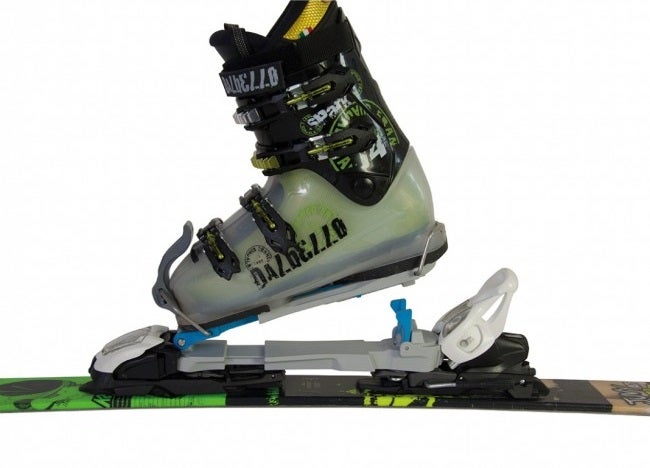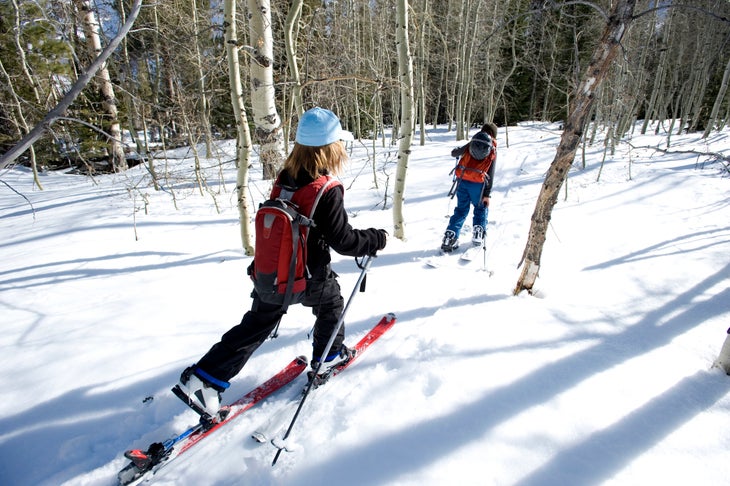Products You May Like
My eight-year-old son Gunnar’s first backcountry trek was a moment I had secretly waited for since he was born, a rite of passage for both of us, and an experience–I assumed–neither of us would ever forget.
And I never will forget the moment about three-and-a-half minutes into our ascent. As he took in the snow-covered spruces, the sparkling reflections of sun rays through floating crystals of ice, the freshly laid skin-track, and adjusted to the rhythm and feeling of his climbing skins and AT binding insert, he turned to me and said:
“Are we there yet?”
Dear reader, we were not there yet. We had barely begun climbing. However, we did eventually make it to our destination because I had laid some physical and mental groundwork ahead-of-time. To backcountry ski is to experience winter in its natural state, to escape crowds, and to get healthy, wholesome, and aerobic exercise. And I had the foresight to appreciate that a youngster like Gunnar may not exactly understand the point.
“It’s about setting attainable goals,” says AMGA-certified ski and rock guide Steve Charest, the dad of a four-year-old and co-owner of Petra Cliffs Climbing Center in Burlington, Vt. “And being flexible about shifting those goals depending on the situation.” An example of such a situation that Charest has encountered on backcountry missions with his little one: “We discover Gruffalo tracks,” says Charest, “on pretty much every outing.”
Heeding Charest’s advice, here are some of the things I did to prepare Gunnar—and myself—for success on our backcountry adventure.
Talk it up.
During family time and meals, I talked about my backcountry adventures, mentioning freshies, “earning your turns,” and boldly going where nobody ever goes—while also acknowledging the challenge of the ascent. “Kids like to look at pictures,” offers Charest. So show your kiddo glimpses of your backcountry experiences. When Gunnar asked questions and expressed interest, I moved onto step two.
Get the gear.
Alpine touring is the fastest growing sector in snowsports, for all the reasons it captures every backcountry enthusiast. The bad news: like adult gear these days, children’s gear is often in short supply, warns Charest. The good news: AT and backcountry gear companies are offering more (and better) options for kids. While you can find backcountry kids skis as small as 120cm, in my mind, Gunnar’s alpine skis serve the same purpose.
Related: The best backcountry ski bindings of the year
Companies like Dynafit, Plum, and Hagan offer AT bindings with lower release values geared towards kids, if you want a dedicated AT setup for your backcountry grom. Likewise, several boot companies (like Salomon, Atomic, and Dynafit) offer smaller boots. The women’s Scarpa F1 boot is available in a 21.5, for example.
Read more: The one-ski setup that takes kids from the resort to the backcountry
For Gunnar, I bought Skimoco’s Contour startup binding adapter, and I used my short kicker skins underneath his 120cm alpine skis—this enabled us to use his alpine setup and not to have to outfit a separate AT kit when we’re just getting our feet wet. While binding adapters may be a bit bulky and awkward, for short trips they get the job done.

Set up and test gear.
I recommend doing this early, and in your living room. What you do not want: equipment challenges at the trailhead. In fact, the more your kid’s kit is set up, ready to go, and living room-tested, when you arrive at the trailhead, the less chance your young backcountry adventurer has to lose focus or interest while you fiddle and make adjustments.
Know what’s important.
Charest used to obsess about bagging peaks or reaching the summit. Now, when he skis with his four-year-old, he has adjusted his priorities. “I’m seeing skin tracks through a four-year-old’s eyes,” he says. In the past, he’d charge along. Now, he accepts stops when his daughter wants to investigate fallen logs, mountain streams, or snowdrifts. “I’m happy we’re spending time in the woods,” he says. “The exploration outweighs getting epic turns.”

Choose the route.
Do not (I repeat, do not) choose Glory Peak in the Teton Pass for your young kid’s first backcountry adventure. If you consider a route challenging, steep, tough, sustained, cruxy, sloggy, or a “burner,” then avoid it for the first outing. Do consider the snowshoe trail at the end of a dirt road; a highway that’s closed in the winter months; or the lower reaches of an established backcountry route—but don’t go all the way to the top. Think minimal effort, maximum reward.
Choose the day.
You never get a second chance to make a first impression. If you have any say in the matter, wait for the perfect day. Don’t subject your kids to the same weather you’d suffer through if you expect them to want to try again another day. If it’s windy, cold, blustery, or otherwise less than ideal, go skiing at your resort. For your first backcountry trip, wait for a knock-their-socks off day.
Bring your dog.
Who can resist the unbridled joy and enthusiasm of a dog in the snow? If you don’t have a dog, think about other worthy distractions and attractions. Thanks to the laws of physics and that pesky force called gravity, eighty percent of backcountry skiing is uphill, and a newbie will find this mentally and physically challenging. What will your child remember that made the experience equal to (or better than) skiing at the resort?
For us, it was our lab Gladys tunneling and digging holes in the snow and frolicking during the descent. It was seeing just one other human. And it was frozen butter—that is, Justin’s Chocolate Hazelnut butter—which, like everything, somehow tastes better at the top of a skin track with sunshine glistening off the snow crystals.
Gunnar and I reached our destination, which is to say, we went “a ways” and then stopped. We had a snack, played with Gladys, watched the sun reflect off airborne crystals, and made tracks on the descent with Gladys prancing between us.
Anyone who thinks that backcountry skiing is an experience unlike any other, try introducing it to a child. Without doing your homework, it can be a nightmare worse than hell itself. But with thoughtful preparation, careful planning, and the right attitude, it can be a gift your child may never forget.
And neither will you.
Mark Aiken is a freelance writer and a ski instructor at Stowe, Vermont. His favorite thing about winter: early morning skinning and fresh tracks before returning to his writing desk. He lives in Richmond, Vermont with his wife, two kids, two dogs, two cats, and nine chickens.
Related Reading
Here’s How to Safely Introduce Your Teens to Backcountry Skiing
Affordable Backcountry Gear That Isn’t Cheap
The Best Backcountry Skis of the Year
